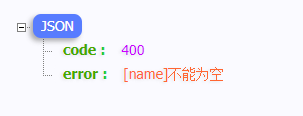怎么在Spring Boot项目中利用JSR-380进行校验?相信很多没有经验的人对此束手无策,为此本文总结了问题出现的原因和解决方法,通过这篇文章希望你能解决这个问题。
JSR-380 是 J2EE 的一个规范,用于校验实体属性,它是 JSR-303 的升级版,在 Spring Boot 中可以基于它优雅实现参数校验。
<!--more-->
在没有使用 JSR-380 之前,我们一般都会将参数校验硬编码在 controller 类中,示例:
public Result add(@RequestBody User user){
if(StringUtils.isBlank(user.getName())){
return Result.error("用户名不能为空");
}
// ...
}而使用 JSR-380 只需要通过添加对应的注解即可实现校验,示例:
@Data
public class User{
@NotBlank
private String name;
private Integer age;
}public Result register(@Validated @RequestBody User user){
// ...
}这样看起来代码是不是清爽了很多,只需要在需要校验的字段上加上对应的校验注解,然后对需要校验的地方加上 @Validated 注解,然后框架就会帮我们完成校验。
框架校验失败之后会抛出异常,需要捕获这个异常然后来自定义校验不通过的错误响应,这里直接贴代码,兼容 @RequestBody 、 @ModelAttribute 、 @RequestParam 三种入参的校验:
@ControllerAdvice
public class GlobalExceptionHandler {
@ExceptionHandler(value = {MethodArgumentNotValidException.class, BindException.class})
public ResponseEntity<Result> methodArgumentNotValidHandler(HttpServletRequest request, Exception e) {
BindingResult bindingResult;
if (e instanceof MethodArgumentNotValidException) {
//@RequestBody参数校验
bindingResult = ((MethodArgumentNotValidException) e).getBindingResult();
} else {
//@ModelAttribute参数校验
bindingResult = ((BindException) e).getBindingResult();
}
FieldError fieldError = bindingResult.getFieldError();
return ResponseEntity.ok(Result.fail(Result.CODE_PARAMS_INVALID, "[" + fieldError.getField() + "]" + fieldError.getDefaultMessage()));
}
//@RequestParam参数校验
@ExceptionHandler(value = {ConstraintViolationException.class, MissingServletRequestParameterException.class})
public ResponseEntity<Result> constraintViolationHandler(Exception e) {
String field;
String msg;
if (e instanceof ConstraintViolationException) {
ConstraintViolation<?> constraintViolation = ((ConstraintViolationException) e).getConstraintViolations().stream().findFirst().get();
List<Path.Node> pathList = StreamSupport.stream(constraintViolation.getPropertyPath().spliterator(), false)
.collect(Collectors.toList());
field = pathList.get(pathList.size() - 1).getName();
msg = constraintViolation.getMessage();
} else {
// 这个不是JSR标准返回的异常,要自定义提示文本
field = ((MissingServletRequestParameterException) e).getParameterName();
msg = "不能为空";
}
return ResponseEntity.ok(Result.fail(Result.CODE_PARAMS_INVALID, "[" + field + "]" + msg));
}
}然后再访问一下接口,可以看到错误提示已经按自定义的规范显示了:

可以看到都不需要写任何提示文本就可以完成校验和提示,上图的 不能为空 是框架内置的 I18N 国际化支持,每个注解都内置相应的提示模板。
常用校验注解
| 注解 | 描述 |
|---|---|
| @NotNull | 验证值不为 null |
| @AssertTrue | 验证值为 true |
| @Size | 验证值的长度介于 min 和 max 之间,可应用于 String、Collection、Map 和数组类型 |
| @Min | 验证值不小于该值 |
| @Max | 验证值不大于该值 |
| 验证字符串是有效的电子邮件地址 | |
| @NotEmpty | 验证值不为 null 或空,可应用于 String、Collection、Map 和数组类型 |
| @NotBlank | 验证字符串不为 null 并且不是空白字符 |
| @Positive | 验证数字为正数 |
| @PositiveOrZero | 验证数字为正数(包括 0) |
| @Negative | 验证数字为负数 |
| @NegativeOrZero | 验证数字为负数(包括 0) |
| @Past | 验证日期值是过去 |
| @PastOrPresent | 验证日期值是过去(包括现在) |
| @Future | 验证日期值是未来 |
| @FutureOrPresent | 验证日期值是未来(包括现在) |
看完上述内容,你们掌握怎么在Spring Boot项目中利用JSR-380进行校验的方法了吗?如果还想学到更多技能或想了解更多相关内容,欢迎关注亿速云行业资讯频道,感谢各位的阅读!
亿速云「云服务器」,即开即用、新一代英特尔至强铂金CPU、三副本存储NVMe SSD云盘,价格低至29元/月。点击查看>>
免责声明:本站发布的内容(图片、视频和文字)以原创、转载和分享为主,文章观点不代表本网站立场,如果涉及侵权请联系站长邮箱:is@yisu.com进行举报,并提供相关证据,一经查实,将立刻删除涉嫌侵权内容。